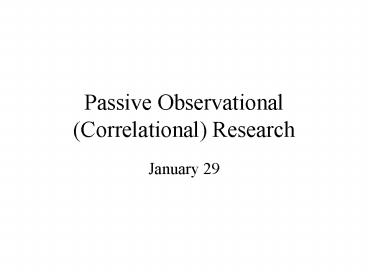Passive Observational Correlational Research PowerPoint PPT Presentation
1 / 35
Title: Passive Observational Correlational Research
1
Passive Observational (Correlational) Research
- January 29
2
Objectives
- Distinguish correlational from experimental.
- Describe why linearity, additivity, reliability,
restriction of range, outliers, subgroup
differences, and multicollinearity are issues,
how to test for them, and what to do about them. - Describe a suppressor and other partial
correlation effects. - Describe information available from MRA and
relation to ANOVA. - Describe the advantages and disadvantages of
path, latent, discriminant, loglinear, and factor
analysis and when and how to use each.
3
Correlational Research
- Misnomer
- Passive observation (no manipulation of
variables) - Can use ANOVA (or can use correlational on
experimental data) - All forms of general linear model
- _________________________ are misapplied terms
4
Linearity
- Correlation and Regression describe a line (with
correlation the difference in standard deviations
are corrected) - However, can transform data or use power terms to
describe curves - E.g., test the significance of a squared term
- Another test of curvilinearity is to categorize
the data, apply ANOVA, get an eta and compare it
to r - Finally, one could look at residuals
5
Additivity
- Regression does not assume independence of
predictors - Does assume additive, but can test products
- E.g., moderation
- Can test incremental validity
- Does variable add significantly to explained
variance? - What is amazing is
6
Reliability
- Reliability of measures attenuates r
- Can correct to estimate true effect, but depends
on purpose (used in meta-analysis and SEM) - If assessing criterion-related validity of scores
of predictor, cannot correct for predictor
unreliability (e.g., validity of
marker/predictor) - If seek estimate of true relationship, okay to
correct both, provided each has reasonable level
of reliability
7
Restriction of range
- Consider correlation between GRE of Yale graduate
students and success in graduate school
8
Outliers and Subgroup Differences
- Outliers are extreme values
- They can occur in either experimental or
correlation research. - Analyze with and without
- Subgroup differences
- If same level of analysis
- Test product term
- Test for significant differences of simple mean
intercepts - If different level of analysis use multilevel
modeling (e.g. HLM)
9
(No Transcript)
10
better
performance
worse
low
high
Self-efficacy
11
Partial and Multiple Correlation
- Effects of each variable partialled from others
12
Partial Correlations
Y
X
Z
13
Suppressor Effects
Y
Z
X
14
Multicollinearity
- R of .90 or r of .80 between exogenous variables
- Creates unstable beta weights
- Suggests multi-measures of single construct
- i.e., Good thing
15
Moderation v. mediation
- Moderation When, who, or which
- Nature of relationship between two variables
depends on level of third (moderator) variable - Mediation Why
- A third variable represents the mechanism through
which a relationship between two other variables
flow
16
Representations (modalities)
- Path
- statistical
- Graphs
17
Path Presentation
18
Path (statistical) Presentation
19
Graphs (Moderation)Crossover Interaction
high
Level 1
DV
Level 2
low
low
high
IV
20
Why MHR
21
Graphs (Moderation)No Effect Interaction
high
Level 1
DV
Level 2
low
low
high
IV
22
Graphs (Moderation)Skewed Interaction
high
Level 1
Level 2
DV
low
low
high
IV
23
Problems with tests of moderation
- Significance of c issue
- difficult (low power) if main effects
- Some argue spurious if random variables
- Use interaction term rather than simple main
effects - What is moderating what?
24
Graphs (Mediation)(not done this way)
high
DV
low
low
high
IV
25
Path (statistical) Presentation
26
Problems with tests of mediation
- Significance of c issue
- .31 .30, ns
- .45.30
- Report effect sizes!
- Sobel test (http//quantrm2.psy.ohio-state.edu/kri
s/sobel/sobel.htm) - Unreliability of mediator and partial mediation
27
Mediation
Y
Z
X
28
Problems with tests of mediation
- Significance of c issue
- .31 .30, ns
- .45.30
- Report effect sizes!
- Sobel test (http//quantrm2.psy.ohio-state.edu/kri
s/sobel/sobel.htm) - Unreliability of mediator and partial mediation
(SEM can correct) - Directions of causality (Can SEM correct?)
29
Directions of Causality Issues
Manipulate IV
Use time precedent
30
Squared Deviations
31
Using moderation to test mediation
- Because of causality issue, may be prudent to
design moderation studies to test mediation
hypotheses. - E.g., attentional resources literature and the
dual task paradigm - Have cognitively distracting, non-cognitively
distracting duel task as factor - Findings of moderation, clue to mediator!
32
Graphs (Mediation)(why clue)
high
DV
low
low
high
IV
33
Factor analysis
- Meaning
- Rotation (orthogonal v. oblique)
- Number of factors
- Meanings
- Eigenvalue of 1
- Scree test
- Creating composite based on factor score or unit
weighting
34
SEM (e.g. LISREL)
- Confirmatory factor analysis
- Path analysis
- Handles partials (direct and indirect effects)
- Latent Structural Equations
- Handles measurement model (see CFA)
- Causality and tests of the model
- Only if strong theory, but that is what you are
testing. - Model completeness (3rd variables, interactions)
- Model fit and alternative models
35
Other Issues
- Dichotomous or categorical endogenous variables
- Use discriminant or chi-square/loglinear
- Particularly as assumptions of normality are
violated - Stepwise
- Use sparingly,
- Capitalizes on chance
- Should have hypotheses to test

